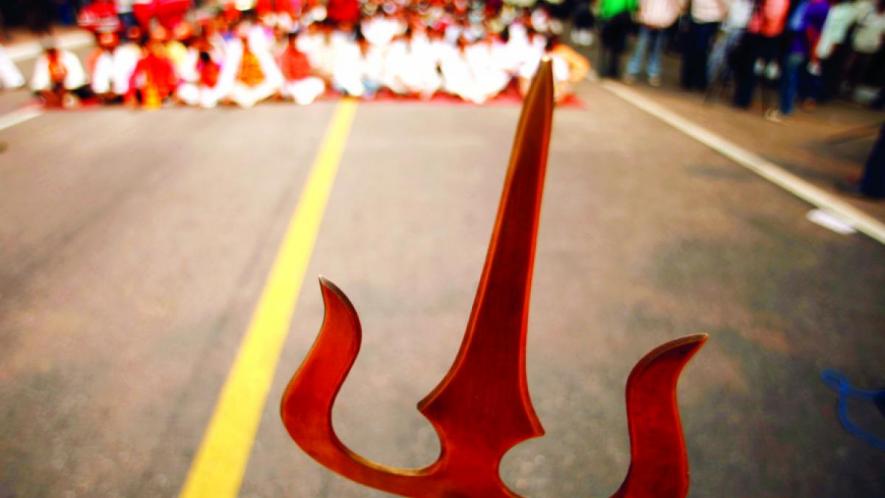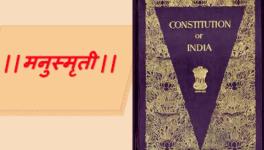Is Hindutva a Duplicate of Hinduism or its Polar Opposite?

Image Courtesy: Counter currents
It is not entirely new, but a relevant debate has begun on a reasonable way to frame the relation between Hinduism as a religion of faith and Hindutva as a practice of ideology. Hinduism is a complex social and cultural phenomenon that combines various contradictory social practices. It took different shapes and forms as it accommodated multiple forms of dissent, yet a core remained that was exclusivist and puritan. Hinduism, at its heart, was a puritanical system that was accommodative and porous: rigid, violent and discriminatory, yet porous, deliberative and accommodative, this is what constitutes Hinduism.
Alongside Vedic Brahmanism, other Shramanic forms of cultural practices emerged, best represented by the Bhakti movement. The German philosopher Hegel argued that Hindu philosophy remained stagnant because of caste and hierarchy. The “oriental spirit” could not move beyond the initial moment, yet Amartya Sen, in his Argumentative Indians, essentially argues that a deliberative process is intrinsic to Hinduism and the cultural way of life. In a different tone, the historian Romila Thapar, too, argues for a “civilisational ethos” marked by dissent and transformation.
Further, sociologist Barrington Moore argues that India did not witness any major rebellion or revolution because of Hinduism, which propagated the theory of Karma wherein the blame for the present condition is shifted to past Karma. This disallowed contradictions. Moore further argues, Gandhi’s strategies of Satyagraha and Ahimsa “struck a chord” with the Hindu way of thinking.
Gandhi offered a way to reconcile contradictions that made a common struggle against colonialism possible. This “third way”, which was neither modern in the capitalist sense nor socialist, was theorised by the historian DD Kosambi. He argued that the mode of production in India moved through “adjustment and not displacement”, marking its similarity with the Gramscian proposition of “passive revolution”. Karl Marx could make only partial sense of this when he demarcated a distinct “Asiatic mode of production”, wherein India had an elaborate division of labour but a stagnant economy. It is Dr Bhimrao Ambedkar who corrected the formulation by arguing that India had not a division of labour but a “division of labourers”. Hinduism and the “Hindu way of life” sought to socially segregate and spatially ghettoise communities according to caste, resulting in “graded inequalities”.
Hindutva is a cultural project attempting to establish a particular structure and an accompanying imagination through political power. From Golwalkar to Savarkar, RSS was embarrassed by the diversity internal to Hinduism and read a source of weakness in it. It saw in its porous and accommodative character a compromise of its inherent strength and order. The RSS, therefore, married the hierarchical traditional imagination with modern concepts of race and nation. It sought to build on exclusionary characteristics by linking notions of purity with territoriality, “motherland”, holy land, and Aryan-supremacist claims.
Hindutva adapts the porous character of Hinduism into rhetoric and, in practice, strengthens its exclusionary and puritan order. The porous internal character of Hinduism could lead to transformation, as historians have claimed. Still, Hindutva has demonstrated how dialectics can also be put to service to establish a new hegemony of dominant groups. Hindutva adopts a dialectical view of “the unity of the opposites”—though not for organic transformation but to establish a Brahmanical social order. It seems to draw on the victory of Brahmanism over Buddhism. It sees a possibility of co-opting the dissenting voices into a new Hindu social order where specificities are internal to a hierarchical order and not external challenges.
Earlier, this process was referred to as Sanskritisation, wherein groups on the lower end of the social spectrum gain a sense of mobility and accommodation by emulating the cultural practices of a dominant group. When Sanskritisation is married with nationalism, it becomes a potent source of psychological inclusion and empowerment. Distinct identities are rendered either an aberration or as signs of exclusion and weakness. So Hindutva links organically to the “Hindu way of life” as well as the subversion of possibilities inherent to it. This is what makes the relation between Hinduism and Hindutva precariously balanced. It strikes an organic chord with a “collective subconscious” while also wishing to block any possible dialectical momentum. It, therefore, consciously claims all that is considered good and civilisational, such as non-violence, yet turns them on its head to gain sanction for violence. While Gandhi read the Bhagavad Gita as a text of non-violence inherent to a Hindu way of life, Hindutva reads the projection of non-violence as a means to gain sanction for violence.
Hindutva, therefore, internally subverts Hinduism by strengthening its most violent and discriminatory aspects. Yet, in its structure and thought processes, it is not entirely external to Hinduism. Therefore, to demarcate Hindutva from Hinduism would not only mean disavowing its philosophical content—which allows deliberation and debates on ideas of the self, spirituality, and otherworldly pursuits—but to also critique, as Ambedkar did, and point out its most brutal exclusions. How does one disown and yet own up to a way of life? Hindutva does this through sleight, partial readings, deliberate misreadings and instrumentalising propositions; it does it in the classical way, accommodating dissenting voices, like that of Ambedkar, even as it empties them of their essence. It accommodates to subjugate, just as Brahmanical Hinduism made a pitch to accommodate Buddha while undermining Buddhist philosophy.
What could be a viable strategy to counter such an elaborate way to disallow contradictions and de-binarise discourses? How do we present the distinction between Hinduism and Hindutva through commonplace symbols that popular consciousness can readily appreciate and follow as everyday practice? Does it lie in reproducing the Gandhian experiment of mixing politics with religion? Should one own the Hindu identity without allowing its hegemonic and discriminatory aspects or disown it for a more modernist separation of religion and politics? Perhaps it is a certain historical lapse of the Gandhian experiment that we are staring at as a crisis named Hindutva.
The writer is Associate Professor at the Centre for Political Studies in Jawaharlal Nehru University, Delhi. The views are personal.
Get the latest reports & analysis with people's perspective on Protests, movements & deep analytical videos, discussions of the current affairs in your Telegram app. Subscribe to NewsClick's Telegram channel & get Real-Time updates on stories, as they get published on our website.























